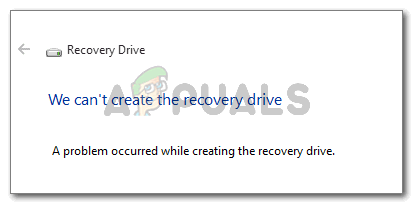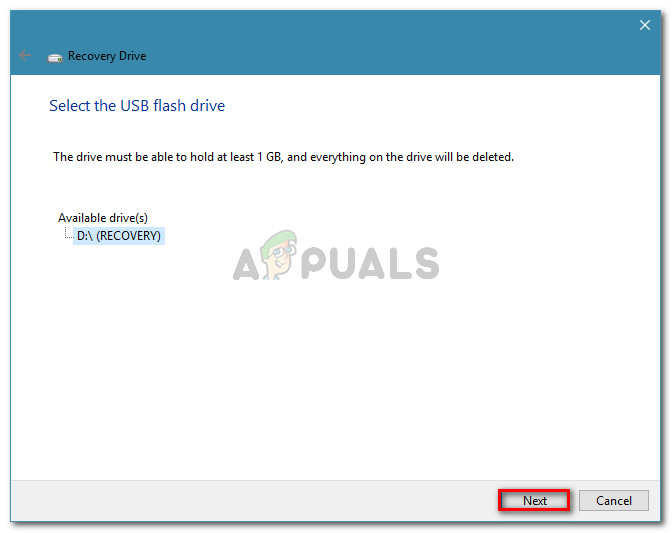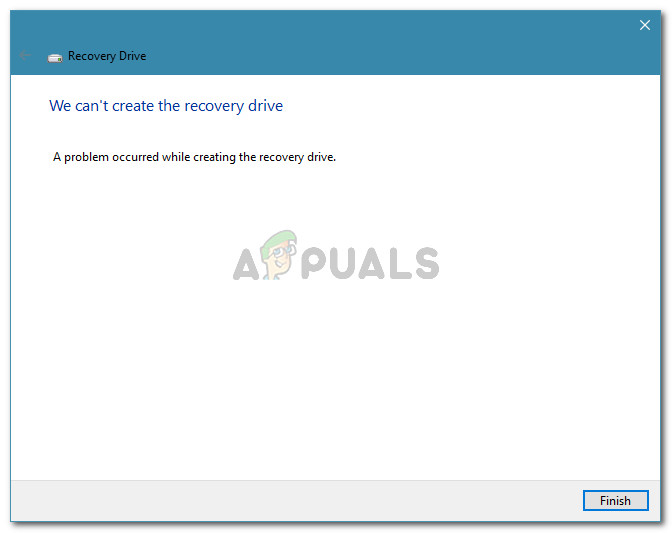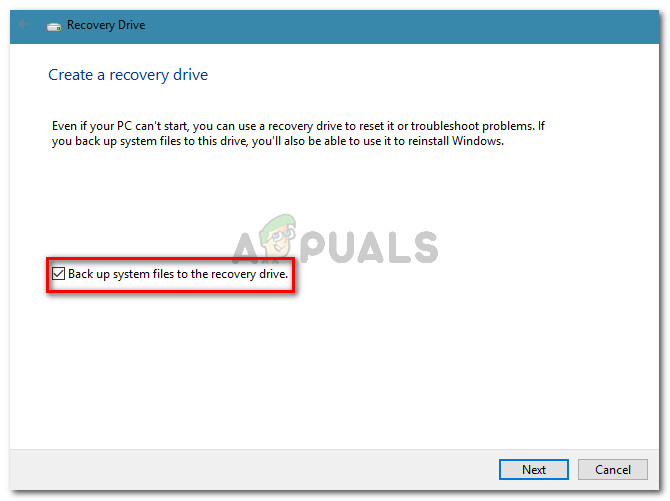Fix: A problem occurred while creating the recovery drive
We Can't create the recovery drive
A lot of users have been reporting problems when trying to create a recovery drive with system files. Apparently, for some users, the process gets terminated before the backup is complete by the “A problem occurred while creating the recovery drive” error. As you can see, the error message is very ambiguous and doesn’t really help us to identify the problem.

A problem occurred while creating the recovery drive
What is causing the “A problem occurred while creating the recovery drive” error?
We have investigated this particular issue by looking at various user reports. From what we gathered, there are several fairly common scenarios that will trigger this particular error message:
- USB drive used in the recovery procedure contains bad sectors – This is the most common reason why this error occurs. As it turns out, if you’re trying to create a recovery drive out of a flash drive, you’ll need to make sure that it doesn’t contain bad sectors.
- Some Microsoft Office services are interfering with the recovery process – Several users have managed to create the recovery drives without issues after they disabled 3 processes used by Microsoft Word and Microsoft Excel.
- Recovery drive wizard glitch – The issue can also occur due to a glitch that is persisting since Windows 7. It can be circumvented by following a set of instructions (Method 3).
- System file corruption – The issue can also occur if the wizard is trying to back up some files that are corrupted. This scenario can typically be resolved by an SFC scan or a repair install (or clean install).
If you’re struggling to resolve this particular issue, this article will provide you with a list of verified troubleshooting steps. Down below, you’ll find a selection of methods that other users in a similar situation have used to get the issue resolved.
For the best results, follow the repair strategies in the order that they are presented until you find a fix that manages to resolve the error in your situation.
Method 1: Formatting the flash drive
Some users encountering the “A problem occurred while creating the recovery drive” error have managed to get the issue resolved by doing a Full format on the USB stick before running RecoveryDrive.exe.
As it turns out, only a Full format is confirmed to resolve the issue as a lot of users have reported that a Fast (Quick) didn’t make any difference. Here’s a quick guide on Full-formatting your flash drive:
- Plug-in your flash drive and open File Explorer.
- Right-click on the flash drive that you plan on using as a recovery drive and choose Format…
- Preserve the same File system and Allocation unit size, but make sure to uncheck the box associated with Quick Format.
- Click Start and wait for the process to complete successfully.
- Hit Yes to confirm the formatting of the flash drive.
- Once the format is complete, open RecoveryDrive.exe again and see if you are able to create the recovery drive without encountering the “A problem occurred while creating the recovery drive”.

If this method wasn’t helpful in your particular scenario, move down to the next method below.
Method 2: Disable 3 services related to Microsoft Office
Other users have managed to resolve the issue by disabling a series of services related to Microsoft Word and Microsoft Excel. Although there’s no official explanation why this fix is effective, users speculate that it probably has something to do with an interference between the Application Virtualization process and Volume Shadow Copies.
Here are the processes that might be involved in the alleged interference:
- Client Virtualization Handler (cvhsvc)
- Application Virtualization Service Agent (sftvsa)
- Application Virtualization Client (sftlist)
Some users encountering the same problem have managed to get the issue resolved by using the System Configuration screen to prevent these 3 processes from being started at the next system startup. Here’s a quick guide on how to do this:
- Press Windows key + R to open up a Run dialog box. Next, type “msconfig” and press Enter to open the System Configuration window.

Run dialog: msconfig - Inside the System Configuration window, click on the Services tab. Then, proceed to uncheck the Service boxes associated with Application Virtualization Client, Application Virtualization Service Agent and Client Virtualization Handler. Once the services have been disabled, click Apply to save the changes.

Disable the three services and press Apply to save the changes - Restart your computer and wait for the next startup is complete. Once it does, open RecoveryDrive.exe and attempt to create the recovery drive again. You should no longer encounter the “A problem occurred while creating the recovery drive” error.
- If this method was successful, return to the System Configuration window (using step 1) and re-enable the processes we previously disabled.
If this method was not effective, move down to the next method below.
Method 3: Using the two-step trick
This might seem like a weird trick, but a lot of users have managed to complete the creation of the recovery drive by running the RecoveryDrive.exe utility in two steps without exiting the program.
There’s no explanation why this works, but users speculate that this probably gets around a Microsoft glitch that was left unaddressed for a couple of years (the issue is also reported to occur on Windows 8 and Windows 7.
To use the two-step recovery trick, you’ll need to get to the end of the Recovery Drive wizard (with the Backup system files to the recovery drive box unchecked) without clicking Finish. Instead, you’ll use Alt + B to get back to the first page to the original screen and then repeat the process with the Back up system files to the recovery drive box checked.
Here’s a step by step guide on how to do this:
- Press Windows key + R to open up a Run dialog box. Then, type “RecoveryDrive.exe” and press Enter to open the Recovery Media Creator tool.

Run dialog: RecoveryDrive.exe - Inside the first window of Recovery Drive, uncheck the box associated with Back up system files to the recovery drive and click Next.

Uncheck the Back up system files to the recovery drive - Select the drive that will be used as a recovery drive, then click the Next button again.

Select the driver to serve as a recovery drive and click Next - In the next screen, click the Create button to begin the recovery drive creation process.

Creating the recovery drive - When you see the “A problem occurred while creating the recovery drive” error, don’t click the Finish button. Instead, press Alt + B to gradually retrace the steps until you arrive at the very start.

Press Alt + B until you return to the starting screen - Now, make sure the Back up system files to the recovery drive checkbox is enabled and go through the steps again. This time, you should be able to complete the process without encountering the “A problem occurred while creating the recovery drive” error again.

Make sure that the Back up system files to the recovery drive checkbox is enabled If this method didn’t help you to create a recovery drive, move down to the next method below.
Method 4: Performing an SFC scan
Some users have reported that the issue was resolved entirely after they ran an SFC scan on their machine. For them, the Recovery Drive started functioning normally after a reboot.
An SFC (System File Checker) scan will investigate the system files for any corruption and replace any identified corrupted occurrences with locally stored healthy copies. This process can take quite a lot of time (depending on your disk size), so make sure you have time for it.
Follow the steps below to perform an SFC scan on your machine:
- Press Windows key + R to open up a Run command. Then, type “cmd” and press Ctrl + Shift + Enter to open an Elevated Command Prompt. When prompted by the UAC (User Account Control), click Yes to grant administrative privileges.

Run dialog: cmd then press Ctrl + Shift + Enter - Inside the Elevated Command Prompt, type “run /scannow” and press Enter to initiate the SFC (System File Checker) scan. Once the scan has been initiated, wait until the process is complete. Do not turn off your computer (or close the CMD window) during this time.

Run the SFC scan and wait until the process is complete - Once the scan has been finished, close the elevated CMD and reboot your machine. At the next startup, see if the issue has been resolved by attempting to create the recovery drive again.
If the “A problem occurred while creating the recovery drive” error is still occuring, move down to the next method below.
Method 5: Performing a clean install or repair install
If you’ve come this far without a result, it’s very likely that your system is suffering from some underlying corruption problem that ended up breaking the Recovery Media Creator tool.
Several users in a similar situation have reported that the method was only resolved after they performed a clean install. If you want to go this route, you can follow our step-by-step article (here).
But there is an even better option that will allow you to reinstall all Windows components without the need to delete your personal files. A repair install will allow you to preserve all your personal files (including images, applications, and user settings) – only the Windows components will be reinstalled. You can perform a repair install by following this guide (here).
Note: if all the options have failed for you, it is strongly recommended to use a bigger flash drive than the one that is being recommended by the computer. One user used a 32GB drive when the system was recommending 16GB and the issue was fixed for them.





